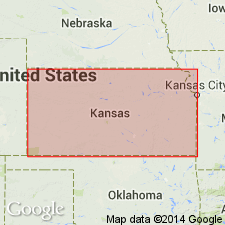
- Usage in publication:
-
- Dog Creek shales
- Modifications:
-
- Original reference
- Dominant lithology:
-
- Shale
- Gypsum
- Dolomite
- AAPG geologic province:
-
- Anadarko basin
- Sedgwick basin
Summary:
Pg. 3, 39. Dog Creek shales in Kiger division. Dull red argillaceous shales, 30 feet thick, with laminae of gypsum in basal part and one or two ledges of dolomite in upper part. Basal formation of Kiger division. Overlain by Red Bluff sandstones and underlain by Shimer gypsum member of Cave Creek formation. [In 1897 (Amer. Geol., v. 19, p. 351-363) Cragin suggested Stony Hills as more appropriate name than Dog Creek for these beds, which he also removed from his Kiger division and included in top of his Salt Fork division.] Age is Permian.
[Named from Dog Creek, Barber Co., central southern KS. Present in Barber, Comanche, and Clark Cos., KS, and in western OK.]
Source: US geologic names lexicon (USGS Bull. 896, p. 618); supplemental information from GNU records (USGS DDS-6; Denver GNULEX).
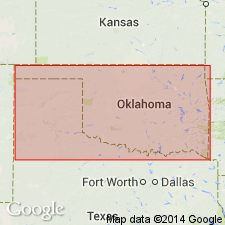
- Usage in publication:
-
- Dog Creek shales
- Modifications:
-
- Revised
- AAPG geologic province:
-
- Anadarko basin
Summary:
Dog Creek shales in Woodward division. Overlies Shimer gypsum of Blaine division. Underlies Red Bluff [Whitehorse] sandstone of Woodward. Age is Permian.
Source: Modified from GNU records (USGS DDS-6; Denver GNULEX).

- Usage in publication:
-
- Dog Creek shale member*
- Modifications:
-
- Revised
- AAPG geologic province:
-
- Anadarko basin
Summary:
Dog Creek shale member of Woodward formation. Clay with thin ledges of magnesium limestone (dolomite in places). Thickness 150 to 225 feet. Underlies Whitehorse sandstone member (formerly †Red Bluff sandstone, preoccupied) of Woodward; overlies Shimer gypsum member of Blaine formation. Age is Permian.
Source: Modified from GNU records (USGS DDS-6; Denver GNULEX).
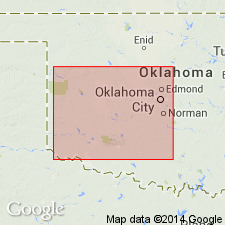
- Usage in publication:
-
- Dog Creek shale
- Modifications:
-
- Revised
- AAPG geologic province:
-
- Anadarko basin
- Palo Duro basin
- South Oklahoma folded belt
Summary:
Dog Creek shale. Raised to formation rank (†Woodward formation "abandoned"). [Woodward "reinstated" as group in 1925 (Oklahoma Geol. Survey Bull., no. 35, p. 94-95).]
Source: Modified from GNU records (USGS DDS-6; Denver GNULEX).

- Usage in publication:
-
- Dog Creek shale*
- Modifications:
-
- Overview
Summary:
Dog Creek shale. Adopted as basal formation of Woodward group in Oklahoma. Overlain by Whitehorse (†Red Bluff) sandstone and underlain by Blaine gypsum. C.N. Gould, 1925 (Oklahoma Geol. Survey Bull., no. 35, p. 91), gave thickness as 30 to 400 feet. Age is Permian.
In central northern Kansas, adopted as Dog Creek shale of Cimarron group.
Source: US geologic names lexicon (USGS Bull. 896, p. 618).
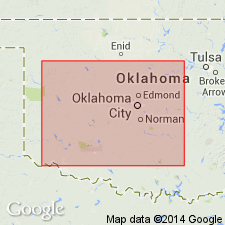
- Usage in publication:
-
- Dog Creek shale
- Modifications:
-
- Areal extent
- AAPG geologic province:
-
- Anadarko basin
- South Oklahoma folded belt
Summary:
Pg. 1469. Dog Creek shale. In central and west-central Oklahoma, in areas where Blaine formation can be identified, Dog Creek shale lies between it and Marlow formation. Thickness about 150 feet at Mountain View [Kiowa County, Oklahoma]; more than 200 feet in Canadian County where it contains several continuous thin dolomites in basal 50 feet. Age is Permian.
Source: US geologic names lexicon (USGS Bull. 1200, p. 1130-1131).

- Usage in publication:
-
- Dog Creek shale
- Modifications:
-
- Areal extent
Summary:
Dog Creek shale. Mapped in Double Mountain group in northwestern Texas. Includes Childress dolomite member at top. Age is Permian.
Source: US geologic names lexicon (USGS Bull. 1200, p. 1130-1131).
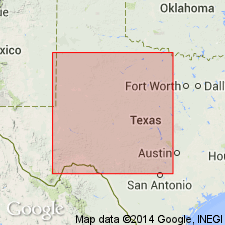
- Usage in publication:
-
- Dog Creek shale*
- Modifications:
-
- Revised
Summary:
Pg. 66 (fig. 1), 98. Dog Creek shale. Top formation of El Reno group on east side of Permian basin. Overlies Blaine gypsum; underlies Whitehorse group. El Reno appears to be better term than recently suggested San Andres group. Age is Early Permian (Leonard).
Source: US geologic names lexicon (USGS Bull. 1200, p. 1130-1131).
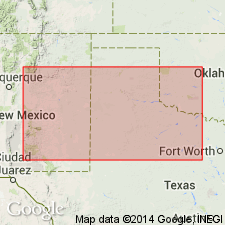
- Usage in publication:
-
- Dog Creek formation
- Modifications:
-
- Biostratigraphic dating
Summary:
Pg. 685-699. Dog Creek formation. Includes (ascending) unnamed shales, Guthrie member, unnamed shales, Aspermont member, unnamed shales and gypsums, and Childress member. Overlies Blaine; underlies Whitehorse. Faunas discussed.
Source: US geologic names lexicon (USGS Bull. 1200, p. 1130-1131).
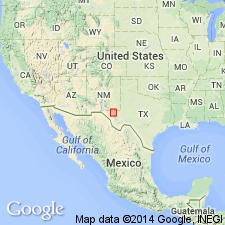
- Usage in publication:
-
- Dog Creek shale*
- Modifications:
-
- Revised
- AAPG geologic province:
-
- Permian basin
Summary:
Pl. 2. Dog Creek shale. Included in El Reno group. †Double Mountain group abandoned. Age is Early Permian (Leonard).
Source: US geologic names lexicon (USGS Bull. 1200, p. 1130-1131).
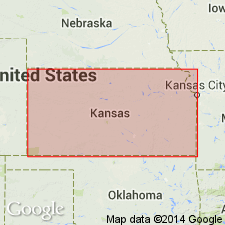
- Usage in publication:
-
- Dog Creek shale
- Modifications:
-
- Revised
Summary:
Pg. 158, 161 (fig. 4). Dog Creek shale. Uppermost formation in Nippewalla group. Consists of maroon shale, sandstone, thin layers of dolomite, dolomitic sandstone, and gypsum. Thickness 14 to 53 feet; average 35 feet. Overlies Blaine formation. Underlies Whitehorse sandstone. In Kiowa County overlapped by Cretaceous sandstone (Cheyenne). Age is Early Permian (Leonardian).
Source: US geologic names lexicon (USGS Bull. 1200, p. 1130-1131).
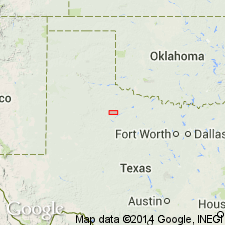
- Usage in publication:
-
- Dog Creek formation
- Modifications:
-
- Revised
Summary:
Pg. 893-907. Pease River group inlcudes San Angelo, Flower-pot, Blaine, and Dog Creek formations as exposed in Texas. Chart shows Pease River group as Guadalupe.
Source: US geologic names lexicon (USGS Bull. 1200, p. 1130-1131).
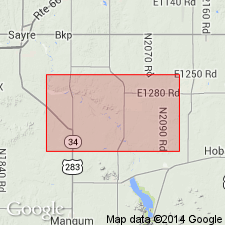
- Usage in publication:
-
- Dog Creek shale
- Modifications:
-
- Areal extent
- AAPG geologic province:
-
- Anadarko basin
Summary:
Pg. 17 (fig. 3), 19 (fig. 4), 28-30, pl. 1. Dog Creek shale of El Reno group. As classified in this report [Carter area, Beckham County, Oklahoma], Dog Creek overlies Van Vacter gypsum member (new) of Blaine formation and underlies Marlow formation of Whitehorse group. Thickness 80 feet. Age is Early Permian (Leonard).
Source: US geologic names lexicon (USGS Bull. 1200, p. 1130-1131).
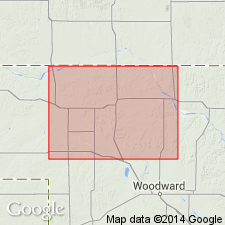
- Usage in publication:
-
- Dog Creek shale
- Modifications:
-
- Areal extent
- AAPG geologic province:
-
- Anadarko basin
Summary:
Pg. 24 (fig. 6), 34-36, pl. 1. Dog Creek shale of El Reno group. Described in Harper County, western Oklahoma, where it conformably overlies Blaine formation and is unconformable below Whitehorse formation. Consists of reddish-buff gypsiferous shale with thin beds of red sandstone and gypsum. Thickness 25 to 50 feet. Uppermost formation of El Reno group. Age is Early Permian (Guadalupian). [On p. 36 refers to El Reno group, Leonardian series.]
Source: US geologic names lexicon (USGS Bull. 1200, p. 1130-1131).
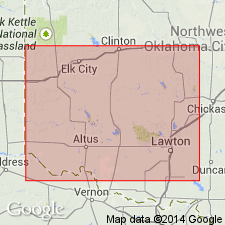
- Usage in publication:
-
- Dog Creek Shale
- Modifications:
-
- Revised
- AAPG geologic province:
-
- Palo Duro basin
Summary:
Is the upper formation of the El Reno Group. Overlies unit 6 of the Van Vacter Member of the Dog Creek Shale. Underlies Whitehorse Group disconformably. Has several widespread gypsum and dolomite beds. Divided into a lower unnamed red-brown and green-gray shale, Hollis Dolomite Bed, Hollis gypsum bed, unnamed red-brown and gray-green shale, Guthrie Dolomite Bed, Guthrie gypsum bed, unnamed red-brown and green-gray shale, and McQueen Gypsum Bed (first used). Recognized in Palo Duro basin of southwest OK and adjoining TX. Measured sections. Permian age.
Source: GNU records (USGS DDS-6; Denver GNULEX).
For more information, please contact Nancy Stamm, Geologic Names Committee Secretary.
Asterisk (*) indicates published by U.S. Geological Survey authors.
"No current usage" (†) implies that a name has been abandoned or has fallen into disuse. Former usage and, if known, replacement name given in parentheses ( ).
Slash (/) indicates name conflicts with nomenclatural guidelines (CSN, 1933; ACSN, 1961, 1970; NACSN, 1983, 2005, 2021). May be explained within brackets ([ ]).

